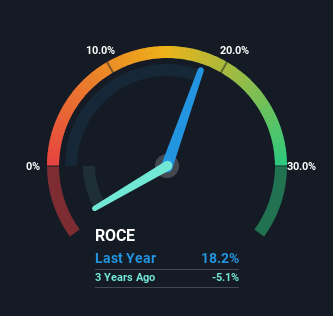- India
- /
- Commercial Services
- /
- NSEI:KOKUYOCMLN
Kokuyo Camlin (NSE:KOKUYOCMLN) Is Doing The Right Things To Multiply Its Share Price

What trends should we look for it we want to identify stocks that can multiply in value over the long term? Typically, we'll want to notice a trend of growing return on capital employed (ROCE) and alongside that, an expanding base of capital employed. This shows us that it's a compounding machine, able to continually reinvest its earnings back into the business and generate higher returns. With that in mind, we've noticed some promising trends at Kokuyo Camlin (NSE:KOKUYOCMLN) so let's look a bit deeper.
Return On Capital Employed (ROCE): What Is It?
For those that aren't sure what ROCE is, it measures the amount of pre-tax profits a company can generate from the capital employed in its business. Analysts use this formula to calculate it for Kokuyo Camlin:
Return on Capital Employed = Earnings Before Interest and Tax (EBIT) ÷ (Total Assets - Current Liabilities)
0.18 = ₹540m ÷ (₹4.2b - ₹1.3b) (Based on the trailing twelve months to December 2023).
Thus, Kokuyo Camlin has an ROCE of 18%. By itself that's a normal return on capital and it's in line with the industry's average returns of 18%.
Check out our latest analysis for Kokuyo Camlin

Historical performance is a great place to start when researching a stock so above you can see the gauge for Kokuyo Camlin's ROCE against it's prior returns. If you'd like to look at how Kokuyo Camlin has performed in the past in other metrics, you can view this free graph of Kokuyo Camlin's past earnings, revenue and cash flow.
What Does the ROCE Trend For Kokuyo Camlin Tell Us?
Kokuyo Camlin is showing promise given that its ROCE is trending up and to the right. Looking at the data, we can see that even though capital employed in the business has remained relatively flat, the ROCE generated has risen by 56% over the last five years. So our take on this is that the business has increased efficiencies to generate these higher returns, all the while not needing to make any additional investments. It's worth looking deeper into this though because while it's great that the business is more efficient, it might also mean that going forward the areas to invest internally for the organic growth are lacking.
On a related note, the company's ratio of current liabilities to total assets has decreased to 30%, which basically reduces it's funding from the likes of short-term creditors or suppliers. So this improvement in ROCE has come from the business' underlying economics, which is great to see.
The Bottom Line
In summary, we're delighted to see that Kokuyo Camlin has been able to increase efficiencies and earn higher rates of return on the same amount of capital. Since the stock has returned a solid 53% to shareholders over the last five years, it's fair to say investors are beginning to recognize these changes. In light of that, we think it's worth looking further into this stock because if Kokuyo Camlin can keep these trends up, it could have a bright future ahead.
If you want to continue researching Kokuyo Camlin, you might be interested to know about the 1 warning sign that our analysis has discovered.
For those who like to invest in solid companies, check out this free list of companies with solid balance sheets and high returns on equity.
Valuation is complex, but we're here to simplify it.
Discover if Kokuyo Camlin might be undervalued or overvalued with our detailed analysis, featuring fair value estimates, potential risks, dividends, insider trades, and its financial condition.
Access Free AnalysisHave feedback on this article? Concerned about the content? Get in touch with us directly. Alternatively, email editorial-team (at) simplywallst.com.
This article by Simply Wall St is general in nature. We provide commentary based on historical data and analyst forecasts only using an unbiased methodology and our articles are not intended to be financial advice. It does not constitute a recommendation to buy or sell any stock, and does not take account of your objectives, or your financial situation. We aim to bring you long-term focused analysis driven by fundamental data. Note that our analysis may not factor in the latest price-sensitive company announcements or qualitative material. Simply Wall St has no position in any stocks mentioned.
About NSEI:KOKUYOCMLN
Kokuyo Camlin
Engages in the manufacturing, trading, and selling of stationery products in India.
Flawless balance sheet second-rate dividend payer.
Similar Companies
Market Insights
Community Narratives



